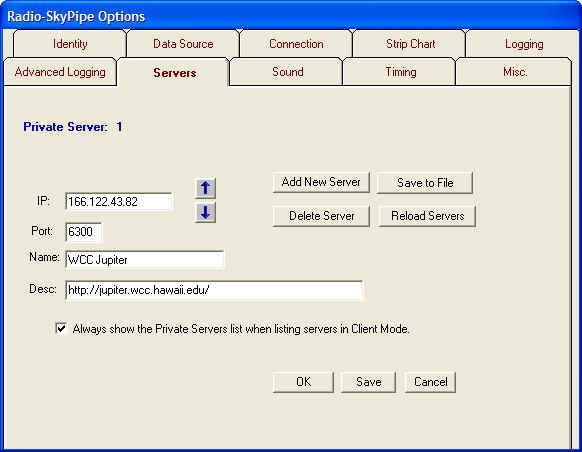

You may keep a list of strip chart servers to which you frequently connect. Some strip chart servers may not wish to publicly publish their presence on the web. These servers can only be connected to if you know their IP address and the Port number on which they listen for connection requests. An example of possible usage might be two experimenters, (let's call them Homer and Charlotte), who share data between their locations but do not want to share their data with others. If Charlotte and Homer do not click the Connect button when in Server Mode or if they have not selected Connect Via Web in their Connection options, others will not see the Charlotte and Homer Local Names and descriptions appear in the Available Servers List.
Homer and Charlotte must know two pieces of information about each other's internet connections in order to exchange strip charts. The IP address is a series of four groups of numbers which uniquely identifies your computer on the internet. Dial up users usually get a new IP address each time they access through their ISP (Internet Service Provider). Thus, if Homer and Charlotte are dial up users, they must somehow tell each other what their IP addresses are. If they have permanent connections or connections which maintain the same address for long periods of time (as with many Cable and DSL type connections) there is less of a problem.
The other bit of information that Homer and Charlotte must share is the Port number that they will be "listening" on for a R-SP strip chart connection. This is an arbitrary number (from 1 to a bit over 32,000), however, since each internet application uses a Port number, you must select one that is not used by another program. Once you find a free Port number you can keep using it. Your program will alert you if you have picked a number that is already in use. It is suggested that you change this number from the default (6300) to another number in the range from 1025 to 9999.
Ok, now our two experimenters know the bits of information which uniquely identifies them. Charlotte puts Homer's IP address in the appropriate place on an unused entry in her Private Server List, which appears under the Servers tab on her Options page. She must be careful to use the proper notation for an IP address with periods separating the four groups of numbers. Next she enters the Port number which Homer has assured her he will be using. If Homer wants to receive Charlotte's strip chart data he does the same thing on his end but using the IP address and Port she has provided to him.
In the Name and Description boxes they can use any information which they feel is appropriate for quick identification.
Scrolling between the possible entries in the Private Server List is accomplished by using the arrow buttons beside the IP and Port boxes. Since this information is kept in a separate file from other R-SP options, you should use the Save to File button to make the changes permanent.
To keep an entry in the Private Servers List from showing up when the list of available servers is displayed, delete the IP address for that entry and save the list.